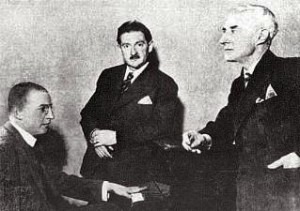
Paul Wittgenstein at the piano with conductor Roger Desormiere and Maruice Ravel
Credit: Wikipedia
In 1932, Ravel was injured in a taxi accident. He lost a couple of teeth and suffered a mild concussion, and possibly experienced whiplash. After receiving acupuncture treatment and hypnosis, Ravel seemingly recovered from his injuries. However, it has been suggested that the accident exacerbated an already existing brain disease, or alternatively, cause more neurological damage than was at first suspected. He did accept a commission to write music for a film about Don Quixote, but it took him the better part of a year to finish the three songs of Don Quichotte à Dulcinée. It was to be his last completed work. In June 1933 Ravel was staying in St. Jean-de-Luz for an early summer holiday. Although he was a strong swimmer, he found himself in difficulties and unable to coordinate his movements, and had to be rescued from the water.
By 1934, it took Ravel an entire week to write a letter of condolence to a friend on the loss of his mother, and he had to consult the dictionary to remind himself how the letters of the alphabet looked. His housekeeper used to pin his address inside his coat when Ravel went out to dinner. On one occasion, Ravel supervised a recording of his string quartet. He sat in the control room and offered various suggestions and corrections. After each movement had been recorded, he was apparently asked if he wanted to listen through it again, but he declined. In that way, the recording session was completed in record time. At the end of that session, Ravel turned to the producer and said, “That was really very good. Remind me of the composer’s name.” On a different occasion, Ravel went to a concert featuring his piano works. He rather enjoyed the performance, and when the hall turned to acclaim him, “he thought they were addressing the Italian colleague at his side, and so joined in their applause.”
It was becoming patently clear to everybody involved that things could not continue in this way. Ravel had consulted a number of neurologists, including the pioneering neurosurgeon Thierry de Martel, who advised against any surgical intervention. Not satisfied, Ravel’s brother Edouard consulted the neurosurgeon Clovis Vincent for a second opinion. Vincent advised surgery on the slim chance that Ravel might have a hidden tumor. Ravel entered a clinic on rue Boileau in Paris, believing that he was just going for a test. In the event, exploratory brain surgery—apparently without adequate anesthetic—was performed on 20 December 1937. Vincent’s operative protocol reveals that the surgeon “exposed the right frontal bone flap revealing a slack brain without actual softening in the area displays. An attempt was made to inflate the right lateral ventricle with 20cc saline solution, but it did not succeed despite repeated attempts. No tumor was found and no biopsy was taken.” Following surgery, Ravel briefly regained some minimal level of consciousness, “but was unable to swallow or take nourishment and lapsed into a coma.” He died aged 62 in the early morning hours of 28 December 1937.
The exact cause of Ravel’s death, or whether it had a direct impact on his musical output, is still much debated. One train of thought suggests that Ravel might have suffered from a degenerative disease of the brain called “Pick’s Disease,” a rare neurodegenerative disease that causes progressive destruction of nerve cells in the brain. Others believe that Ravel’s illness belonged to a group of cerebral atrophies accompanied by ventricular enlargement. This has led to speculation that Ravel had undergone a procedure called “pneumoencephalography,” which drains the cerebrospinal fluid from around the brain and replaces it with oxygen or helium to allow the structure of the brain to be imaged on X-ray film. Since no radiologic films or reports have been discovered, it is still unclear whether Ravel had undergone this procedure. At any rate, there is a growing body of literature attempting to discover signs of Ravel’s neurological decline in two of his later compositions. Boléro and his Concerto for the Left Hand are frequently cited, but we might do well to look beyond the musical surface; the former was classified by Ravel as a study in orchestration, while the latter represented a commission from the eccentric Viennese pianist Paul Wittgenstein, who had lost his right arm in World War I.
Maurice Ravel: Don Quichotte à Dulcinée



